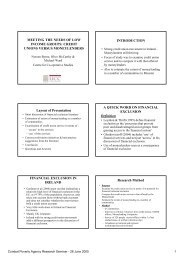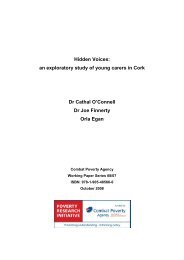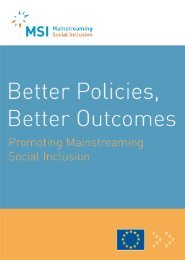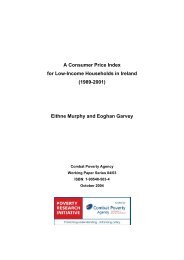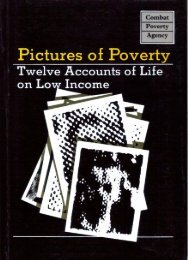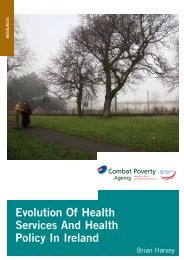The Distribution of Income in Ireland (2000) - Combat Poverty Agency
The Distribution of Income in Ireland (2000) - Combat Poverty Agency
The Distribution of Income in Ireland (2000) - Combat Poverty Agency
- No tags were found...
Create successful ePaper yourself
Turn your PDF publications into a flip-book with our unique Google optimized e-Paper software.
60 <strong>The</strong> <strong>Distribution</strong> <strong>of</strong> <strong>Income</strong> <strong>in</strong> <strong>Ireland</strong>Table 5.7: G<strong>in</strong>i Coefficient for Equivalised Disposable<strong>Income</strong> among Persons <strong>in</strong> ECHP Wave 1, 1993, and Wave 2,1994, Modified OECD ScaleDenmarkNetherlandsBelgiumGermanyLuxembourgFranceItalySpa<strong>in</strong><strong>Ireland</strong>UKGreecePortugalWavel(1993)0.220.270.280.290.310.310.320.340.340.350.350.39Rank<strong>in</strong>g123455788101012G<strong>in</strong>iWave 2(1994)0.240.290.280.290.280.290.310.320.330.320.340.375.3 EARLIER COMPARATIVE INCOME DISTRIBUTIONRESULTSRank<strong>in</strong>gHav<strong>in</strong>g presented figures for <strong>Ireland</strong>'s <strong>in</strong>come distributioncompared with other EU countries <strong>in</strong> the mid-1990s <strong>in</strong> thefc^HP, it is useful to compare these with results from earliercross-country comparative exercises. <strong>The</strong> most useful po<strong>in</strong>t <strong>of</strong>comparison is the comprehensive study <strong>of</strong> <strong>in</strong>come <strong>in</strong>equalitybyESS TAtk<strong>in</strong>son ' Ra<strong>in</strong>water and Smeed<strong>in</strong>g (1995) for theOECD. This was based primarily on data from the Luxembourg<strong>Income</strong> Study (US) database and focused on surveys carriedout between 1984-1988. <strong>The</strong> <strong>in</strong>come concept, recipient unit andaccount<strong>in</strong>g period employed was similar to that used <strong>in</strong> thetCHP, the mam focus be<strong>in</strong>g on disposable household <strong>in</strong>comer^m e ?iTl r 3 y6ar WlthOUt mcludm 9 for ^ p l e imputedent. (Unlike the ECHP, the datasets <strong>in</strong> LIS come from nationalmharmonisedfcTn?^ ^^ source: areas where datafor particular countries departed from the desired measure <strong>of</strong>142424781081112<strong>Ireland</strong>'s <strong>Income</strong> <strong>Distribution</strong> <strong>in</strong> International Perspective 61<strong>in</strong>come or the household unit are discussed <strong>in</strong> Atk<strong>in</strong>son, Ra<strong>in</strong>waterand Smeed<strong>in</strong>g, Chapter 3.) <strong>The</strong>y present results on thedistribution <strong>of</strong> <strong>in</strong>come for n<strong>in</strong>e out <strong>of</strong> the eleven countries covered<strong>in</strong> this study — they did not have data for Denmark orGreece — us<strong>in</strong>g the square root equivalence scale and personweight<strong>in</strong>g.<strong>The</strong>se can be compared with the figures presented above,and for convenience we focus <strong>in</strong> Table 5.8 on the G<strong>in</strong>i coefficient.<strong>The</strong>re are major differences for some countries betweenthe two sets <strong>of</strong> results. As summarised <strong>in</strong> the G<strong>in</strong>i coefficient,the level <strong>of</strong> <strong>in</strong>equality <strong>in</strong> the ECHP was a good deal higher than<strong>in</strong> the Atk<strong>in</strong>son, Ra<strong>in</strong>water and Smeed<strong>in</strong>g (1995) results forGermany, Belgium, Luxembourg, the UK, Spa<strong>in</strong> and Portugal.For the Netherlands, France, <strong>Ireland</strong> and Italy the ECHP estimatesare similar to those <strong>in</strong> Atk<strong>in</strong>son et al. It is known from nationalstudies that the level <strong>of</strong> <strong>in</strong>come <strong>in</strong>equality did <strong>in</strong>deed risebetween the mid-1980s and the mid-1990s <strong>in</strong> some EU countries,notably the UK. On this basis the <strong>in</strong>crease <strong>in</strong> the UK G<strong>in</strong>icoefficient appears broadly consistent with external evidence(see, for example, Goodman, Johnson and Webb, 1997). 2 Some<strong>in</strong>crease <strong>in</strong> <strong>in</strong>equality <strong>in</strong> Belgium up to 1992 is suggested bynational sources (see Cantillon et al. 1994), but not as great asthe gap between the Atk<strong>in</strong>son, Ra<strong>in</strong>water and Smeed<strong>in</strong>g andECHP figures. 3 It would, however, be surpris<strong>in</strong>g if the level <strong>of</strong><strong>in</strong>equality had <strong>in</strong>creased <strong>in</strong> Luxembourg and Portugal by asmuch as this comparison suggests, particularly when the Atk<strong>in</strong>son,Smeed<strong>in</strong>g and Ra<strong>in</strong>water results for Portugal refer to1989/90.2 <strong>The</strong> latter cannot be compared directly with either Atk<strong>in</strong>son et al. or theECHP results because a different equivalence scale is used.Cantillon et al. (1994) show the G<strong>in</strong>i coefficient <strong>in</strong>creas<strong>in</strong>g from 0.225 <strong>in</strong> 1985to 0.237 <strong>in</strong> 1992, us<strong>in</strong>g a different equivalence scale.




